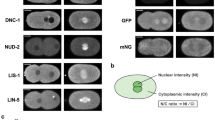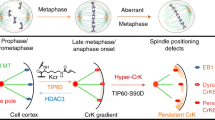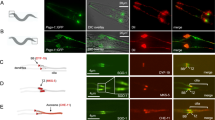Abstract
Asymmetric cell division requires the orientation of mitotic spindles along the cell-polarity axis. In Drosophila neuroblasts, this involves the interaction of the proteins Inscuteable (Insc) and Partner of inscuteable (Pins). We report here that a human Pins-related protein, called LGN, is instead essential for the assembly and organization of the mitotic spindle. LGN is cytoplasmic in interphase cells, but associates with the spindle poles during mitosis. Ectopic expression of LGN disrupts spindle-pole organization and chromosome segregation. Silencing of LGN expression by RNA interference also disrupts spindle-pole organization and prevents normal chromosome segregation. We found that LGN binds the nuclear mitotic apparatus protein NuMA, which tethers spindles at the poles, and that this interaction is required for the LGN phenotype. Anti-LGN antibodies and the LGN-binding domain of NuMA both trigger microtubule aster formation in mitotic Xenopusegg extracts, and the NuMA-binding domain of LGN blocks aster assembly in egg extracts treated with taxol. Thus, we have identified a mammalian Pins homologue as a key regulator of spindle organization during mitosis.
This is a preview of subscription content, access via your institution
Access options
Subscribe to this journal
Receive 12 print issues and online access
$209.00 per year
only $17.42 per issue
Buy this article
- Purchase on SpringerLink
- Instant access to full article PDF
Prices may be subject to local taxes which are calculated during checkout







Similar content being viewed by others
References
Schober, M., Schaefer, M. & Knoblich, J. A. Bazooka recruits Inscuteable to orient asymmetric cell divisions in Drosophila neuroblasts. Nature 402, 548–551 (1999).
Wodarz, A., Ramrath, A., Kuchinke, U. & Knust, E. Bazooka provides an apical cue for Inscuteable localization in Drosophila neuroblasts. Nature 402, 544–547 (1999).
Yu, F., Morin, X., Cai, Y., Yang, X. & Chia, W. Analysis of partner of inscuteable, a novel player of Drosophila asymmetric divisions, reveals two distinct steps in inscuteable apical localization. Cell 100, 399–409 (2000).
Schaefer, M., Shevchenko, A. & Knoblich, J. A. A protein complex containing Inscuteable and the Galpha-binding protein Pins orients asymmetric cell divisions in Drosophila. Curr. Biol. 10, 353–362 (2000).
Joberty, G., Petersen, C., Gao, L. & Macara, I. G. The cell-polarity protein Par6 links Par3 and atypical protein kinase C to Cdc42. Nature Cell Biol. 2, 531–539 (2000).
Mochizuki, N., Cho, G., Wen, B. & Insel, P. A. Identification and cDNA cloning of a novel human mosaic protein, LGN, based on interaction with G alpha i2. Gene 181, 39–43 (1996).
Takesono, A. et al. Receptor-independent activators of heterotrimeric G-protein signaling pathways. J. Biol. Chem. 274, 33202–33205. (1999).
Parmentier, M. L. et al. Rapsynoid/Partner of Inscuteable controls asymmetric division of larval neuroblasts in Drosophila. J. Neurosci. (Online) 20, RC84 (2000).
Blatch, G. L. & Lassle, M. The tetratricopeptide repeat: a structural motif mediating protein-protein interactions. BioEssays 21, 932–939 (1999).
Siderovski, D. P., Diverse-Pierluissi, M. & De Vries, L. The GoLoco motif: a Galphai/o binding motif and potential guanine-nucleotide exchange factor. Trends Biochem. Sci. 24, 340–341 (1999).
Natochin, M. et al. AGS3 inhibits GDP dissociation from Galpha subunits of the Gi family and rhodopsin-dependent activation of transducin. J. Biol. Chem. 275, 40981–40985 (2000).
Bernard, M. L., Peterson, Y. K., Chung, P., Jourdan, J. & Lanier, S. M. Selective interaction of AGS3 with G-proteins and the influence of AGS3 on the activation state of G-proteins. J. Biol. Chem. 276, 1585–1593 (2001).
Schuyler, S. C. & Pellman, D. Search, capture and signal: games microtubules and centrosomes play. J. Cell Sci. 114, 247–255 (2001).
Gordon, M. B., Howard, L. & Compton, D. A. Chromosome movement in mitosis requires microtubule anchorage at spindle poles. J. Cell Biol. 152, 425–434 (2001).
Gaglio, T. et al. Opposing motor activities are required for the organization of the mammalian mitotic spindle pole. J. Cell Biol. 135, 399–414 (1996).
Merdes, A., Heald, R., Samejima, K., Earnshaw, W. C. & Cleveland, D. W. Formation of spindle poles by dynein/dynactin-dependent transport of NuMA. J. Cell Biol. 149, 851–862 (2000).
Harborth, J., Wang, J., Gueth-Hallonet, C., Weber, K. & Osborn, M. Self assembly of NuMA: multiarm oligomers as structural units of a nuclear lattice. EMBO J. 18, 1689–1700 (1999).
Nachury, M. V. et al. Importin beta is a mitotic target of the small GTPase Ran in spindle assembly. Cell 104, 95–106 (2001).
Wiese, C. et al. Role of importin-beta in coupling Ran to downstream targets in microtubule assembly. Science 291, 653–656 (2001).
Scholey, J. M., Rogers, G. C. & Sharp, D. J. Mitosis, microtubules, and the matrix. J. Cell Biol. 154, 261–266 (2001).
Compton, D. A. & Cleveland, D. W. NuMA is required for the proper completion of mitosis. J. Cell Biol. 120, 947–957 (1993).
Gaglio, T., Saredi, A. & Compton, D. A. NuMA is required for the organization of microtubules into aster-like mitotic arrays. J. Cell Biol. 131, 693–708 (1995).
Yang, C. H. & Snyder, M. The nuclear-mitotic apparatus protein is important in the establishment and maintenance of the bipolar mitotic spindle apparatus. Mol. Biol. Cell 3, 1259–1267 (1992).
Yang, C. H., Lambie, E. J. & Snyder, M. NuMA: an unusually long coiled-coil related protein in the mammalian nucleus. J. Cell Biol. 116, 1303–1317 (1992).
Compton, D. A., Szilak, I. & Cleveland, D. W. Primary structure of NuMA, an intranuclear protein that defines a novel pathway for segregation of proteins at mitosis. J. Cell Biol. 116, 1395–1408 (1992).
Merdes, A., Ramyar, K., Vechio, J. D. & Cleveland, D. W. A complex of NuMA and cytoplasmic dynein is essential for mitotic spindle assembly. Cell 87, 447–458 (1996).
Gueth-Hallonet, C., Weber, K. & Osborn, M. NuMA: a bipartite nuclear location signal and other functional properties of the tail domain. Exp. Cell Res. 225, 207–218 (1996).
Elbashir, S. M., Lendeckel, W. & Tuschl, T. RNA interference is mediated by 21- and 22-nucleotide RNAs. Genes Dev. 15, 188–200 (2001).
Elbashir, S. M. et al. Duplexes of 21-nucleotide RNAs mediate RNA interference in cultured mammalian cells. Nature 411, 494–498 (2001).
De Vries, L. et al. Activator of G protein signaling 3 is a guanine dissociation inhibitor for Galpha i subunits. Proc. Natl Acad. Sci. USA 97, 14364–14369 (2000).
Miller, K. G. & Rand, J. B. A role for RIC-8 (Synembryn) and GOA-1 (G(o)alpha) in regulating a subset of centrosome movements during early embryogenesis in Caenorhabditis elegans. Genetics 156, 1649–1660 (2000).
Gotta, M. & Ahringer, J. Distinct roles for Gα and Gβγ in regulating spindle position and orientation in Caenorhabditis elegans embryos. Nature Cell Biol. 3, 297–300 (2001).
Joberty, G., Perlungher, R. R. & Macara, I. G. The Borgs, a new family of Cdc42 and TC10 GTPase-interacting proteins. Mol. Cell. Biol. 19, 6585–6597 (1999).
Jou, T. S. & Nelson, W. J. Effects of regulated expression of mutant RhoA and Rac1 small GTPases on the development of epithelial (MDCK) cell polarity. J. Cell Biol. 142, 85–100 (1998).
Barth, A. I., Pollack, A. L., Altschuler, Y., Mostov, K. E. & Nelson, W. J. NH2-terminal deletion of beta-catenin results in stable colocalization of mutant beta-catenin with adenomatous polyposis coli protein and altered MDCK cell adhesion. J. Cell Biol. 136, 693–706 (1997).
Murray, A. W. Cell cycle extracts. Methods Cell Biol. 36, 581–605 (1991).
Stukenberg, P. T. et al. Systematic identification of mitotic phosphoproteins. Curr. Biol. 7, 338–348 (1997).
Desai, A., Murray, A., Mitchison, T. J. & Walczak, C. E. The use of Xenopus egg extracts to study mitotic spindle assembly and function in vitro. Methods Cell Biol. 61, 385–412 (1999).
Acknowledgements
We thank G. Post (University of Kentucky) for the human LGN cDNA, J. Casanova (University of Virginia) for the MDCK T23 cell line, Duane Compton (Dartmouth Medical School) for anti-NuMA antibodies and NuMA cDNA, and members of the Macara group for reagents and helpful discussions. We also thank T. Tuschl for information on designing and using siRNA duplexes. This work was supported by grant CA40042 from the NIH, DHHS.
Author information
Authors and Affiliations
Corresponding author
Supplementary information
Supplementary Figures
Figure S1 Effects of LGN overexpression on microtubule organization in mitotic HeLa cells. (PDF 397 kb)
Figure S2 Ectopically expressed Myc–LGN-N(1′340) co-localizes with NuMA in interphase cell nuclei and disrupts the normal distribution of NuMA.
Rights and permissions
About this article
Cite this article
Du, Q., Stukenberg, P. & Macara, I. A mammalian Partner of inscuteable binds NuMA and regulates mitotic spindle organization. Nat Cell Biol 3, 1069–1075 (2001). https://doi.org/10.1038/ncb1201-1069
Received:
Revised:
Accepted:
Published:
Issue Date:
DOI: https://doi.org/10.1038/ncb1201-1069
This article is cited by
-
Spindle positioning and its impact on vertebrate tissue architecture and cell fate
Nature Reviews Molecular Cell Biology (2021)
-
NuMA regulates mitotic spindle assembly, structural dynamics and function via phase separation
Nature Communications (2021)
-
Altered cleavage plane orientation with increased genomic aneuploidy produced by receptor-mediated lysophosphatidic acid (LPA) signaling in mouse cerebral cortical neural progenitor cells
Molecular Brain (2020)
-
A human cell polarity protein Lgl2 regulates influenza A virus nucleoprotein exportation from nucleus in MDCK cells
Journal of Biosciences (2020)
-
Hexameric NuMA:LGN structures promote multivalent interactions required for planar epithelial divisions
Nature Communications (2019)



